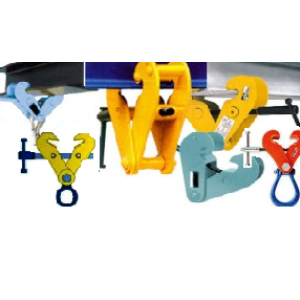
We get asked about beam clamps quite
regularly, so we thought it would be helpful to put together a proper guide
covering the basics and what you need to know.
A beam clamp's job is straightforward - it
grips securely onto steel beams to create a lifting point for hoists and other
equipment. The clamp attaches to the flanges of RSJ, H-beam, or I-beam
structures without requiring any permanent modifications.
Most of our customers choose beam clamps
because they want to avoid drilling holes in their structural steelwork. Once
you drill into a beam, you've potentially weakened it. Beam clamps simply clamp
on, do their job, and can be removed when you're finished.
We've been working with lifting equipment
for over 30 years now, and beam clamps remain one of our most versatile
products in their application.
Construction sites are where we see most of
our beam clamps in use. Contractors use them for positioning air conditioning
units, moving structural steel, and general material handling tasks.
One of our regular customers runs a
manufacturing workshop in Birmingham. When his overhead crane broke down, we
supplied him with a portable gantry system and beam clamps as a temporary
solution. That was three years ago - he's never bothered fixing the original
crane and keeps ordering more clamps for different areas of his workshop.
We also supply quite a few schools and
colleges who use them for stage lighting installations. It makes sense really -
you can't have the drama department drilling holes in the assembly hall
ceiling.
The theatre and events industry is a bit
outside our usual area of expertise, though we do supply some major venues in
London. Different requirements to our typical construction customers, but the
basic principle remains the same.
Getting the beam measurements right is
crucial. You need to know both the flange thickness and width before ordering.
Guessing these dimensions is asking for trouble - either the clamp won't fit
properly, or worse, it might not grip securely.
We've had customers send photos of clamps
that aren't seated correctly because they estimated the beam size rather than
measuring it. Always measure twice, order once.
Safe working loads need careful
consideration too. Don't just match the clamp capacity to your load weight -
allow some safety margin. For straightforward lifts, I'd suggest at least
25-30% above your actual load. For more complex operations or if you're unsure
about any aspect of the lift, go for a higher capacity clamp.
Better to over-spec and be safe than cut
things fine.
LOLER compliance is mandatory - all our
beam clamps come with the necessary certification and documentation, but
regular inspections are your responsibility.
Before each use, check the clamp for any
damage. Look for thread wear, cracks in the body, or anything that prevents
smooth operation. If there's any doubt about the condition, don't use it.
The condition of the beam itself matters
too. Paint, rust, or oil contamination can affect the clamp's grip. Clean the
beam flanges properly before installation - a wire brush takes seconds and
could prevent a serious accident.
Proper tightening is important but don't
overdo it. There's a balance between adequate grip and damaging either the
clamp or the beam structure.
We primarily stock screw-type beam clamps.
They're reliable, fully adjustable, and suitable for most applications. They
take a little longer to position than some alternatives but offer excellent
security once properly installed.
For heavy-duty applications, we have
reinforced models designed for larger loads. These cost more but are engineered
for demanding industrial use.
Our technical team can provide more
specific guidance on specialised requirements.
The biggest error we see is people not
considering the beam's load capacity. Your clamp might be rated for several
tonnes, but if the beam structure can't handle that load, you have a problem.
For significant lifts, always consult with a structural engineer.
Rushing the installation process is another
issue. We understand there's always pressure to get the job done quickly but
taking a few extra minutes to position everything correctly will save time and
prevent problems later.
Using damaged equipment is unfortunately
more common than it should be. If a clamp shows any signs of damage or
excessive wear, replace it. The cost of a new clamp is insignificant compared
to the potential consequences of equipment failure.
Before beam clamps became widely available,
creating temporary lifting points was complicated and time-consuming. You'd
need to weld brackets, drill mounting holes, or make other permanent
modifications to the structure.
Now you can install a secure lifting point
in minutes, move it as needed, and remove it completely when the job's
finished. No structural alterations, no permanent changes - just clean,
efficient lifting solutions.
Beam clamps are straightforward tools that
solve a common problem effectively. Choose the correct size for your beam,
observe proper safety procedures, and they'll provide years of reliable
service.
If you're unsure about specifications or
have specific requirements, please get in touch. Our team can certainly help
you select the right equipment for your needs.
For technical advice or product
enquiries, call us on 01384 76961 or use our website contact form. We're always
happy to help customers find the right lifting solutions.